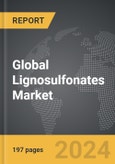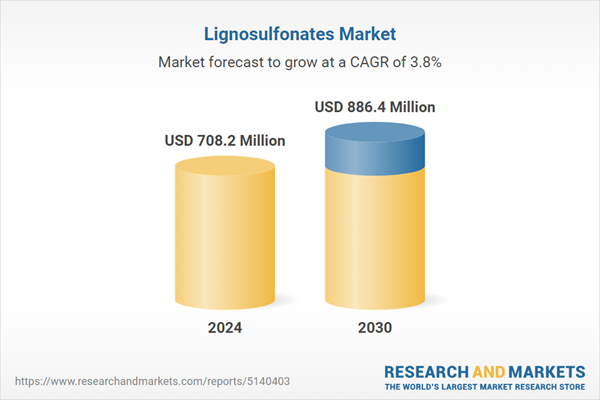The global market for Lignosulfonates was valued at US$708.2 Million in 2024 and is projected to reach US$886.4 Million by 2030, growing at a CAGR of 3.8% from 2024 to 2030. This comprehensive report provides an in-depth analysis of market trends, drivers, and forecasts, helping you make informed business decisions. The report includes the most recent global tariff developments and how they impact the Lignosulfonates market.
Segments: Type (Sodium, Calcium, Magnesium, Other Types); Application (Animal Feed Binder, Concrete Admixtures, Dust Control, Oil Well Additives, Other Applications).
Geographic Regions/Countries: World; United States; Canada; Japan; China; Europe (France; Germany; Italy; United Kingdom; Spain; Russia; and Rest of Europe); Asia-Pacific (Australia; India; South Korea; and Rest of Asia-Pacific); Latin America (Argentina; Brazil; Mexico; and Rest of Latin America); Middle East (Iran; Israel; Saudi Arabia; United Arab Emirates; and Rest of Middle East); and Africa.
The analysts continuously track trade developments worldwide, drawing insights from leading global economists and over 200 industry and policy institutions, including think tanks, trade organizations, and national economic advisory bodies. This intelligence is integrated into forecasting models to provide timely, data-driven analysis of emerging risks and opportunities.
Global Lignosulfonates Market - Key Trends & Drivers Summarized
Why Are Lignosulfonates Gaining Popularity in Various Industrial Applications?
Lignosulfonates, a byproduct of the wood pulping process, have gained popularity in various industrial applications due to their versatile properties as dispersants, binders, and emulsifiers. These natural polymers are widely used in industries such as construction, agriculture, animal feed, and chemicals, where they help improve the efficiency and performance of various processes. In construction, lignosulfonates are used as plasticizers and water reducers in concrete, enhancing workability and strength while reducing water content. In agriculture, they serve as dispersants in pesticide formulations, improving the effectiveness of crop protection products. The increasing demand for sustainable and cost-effective solutions in these industries is driving the adoption of lignosulfonates, as they offer an environmentally friendly alternative to synthetic chemicals and additives.How Are Technological Advancements Enhancing the Use of Lignosulfonates?
Technological advancements are expanding the potential applications of lignosulfonates, making them more efficient and versatile in industrial processes. Innovations in the extraction and processing of lignosulfonates are improving their purity and consistency, enhancing their performance in various applications. The development of new formulations and blends of lignosulfonates is enabling their use in more demanding environments, such as high-performance concrete and advanced agricultural products. Additionally, advancements in chemical modification techniques are allowing for the customization of lignosulfonates to meet specific industry needs, such as improved solubility, stability, and compatibility with other materials. These technological improvements are broadening the range of applications for lignosulfonates and driving their adoption in industries seeking sustainable and cost-effective solutions.What Market Trends Are Driving the Demand for Lignosulfonates?
Several market trends are driving the demand for lignosulfonates, particularly the growing focus on sustainability, cost efficiency, and the use of natural products. In the construction industry, the trend towards green building practices and the need for sustainable materials are boosting the use of lignosulfonates as an environmentally friendly additive in concrete and other construction products. The increasing demand for efficient and sustainable agricultural practices is also contributing to the adoption of lignosulfonates as dispersants in pesticide formulations and soil conditioners. In the animal feed industry, the use of lignosulfonates as binders is growing, driven by the need for cost-effective and natural feed additives. Additionally, the rising interest in bio-based chemicals and the circular economy is supporting the use of lignosulfonates as a sustainable alternative to synthetic chemicals in various industrial processes.What Is Driving the Growth in the Lignosulfonates Market?
The growth in the lignosulfonates market is driven by several factors. The increasing demand for sustainable and eco-friendly solutions in construction, agriculture, and other industries is a significant driver, as lignosulfonates offer a natural alternative to synthetic additives and chemicals. Technological advancements in the extraction, processing, and application of lignosulfonates are enhancing their performance and broadening their range of uses, further driving market growth. The growing focus on cost efficiency and the need to reduce the environmental impact of industrial activities are also contributing to the adoption of lignosulfonates. Additionally, the expansion of industrial activities in emerging markets, where sustainable and cost-effective solutions are in high demand, is creating new opportunities for lignosulfonate manufacturers. The increasing awareness of the benefits of lignosulfonates and the trend towards bio-based chemicals are further fueling market growth, as industries seek to adopt more sustainable and environmentally friendly practices.Report Scope
The report analyzes the Lignosulfonates market, presented in terms of units. The analysis covers the key segments and geographic regions outlined below.Segments: Type (Sodium, Calcium, Magnesium, Other Types); Application (Animal Feed Binder, Concrete Admixtures, Dust Control, Oil Well Additives, Other Applications).
Geographic Regions/Countries: World; United States; Canada; Japan; China; Europe (France; Germany; Italy; United Kingdom; Spain; Russia; and Rest of Europe); Asia-Pacific (Australia; India; South Korea; and Rest of Asia-Pacific); Latin America (Argentina; Brazil; Mexico; and Rest of Latin America); Middle East (Iran; Israel; Saudi Arabia; United Arab Emirates; and Rest of Middle East); and Africa.
Key Insights:
- Market Growth: Understand the significant growth trajectory of the Sodium segment, which is expected to reach US$344.4 Million by 2030 with a CAGR of a 3.9%. The Calcium segment is also set to grow at 4.2% CAGR over the analysis period.
- Regional Analysis: Gain insights into the U.S. market, valued at $189.7 Million in 2024, and China, forecasted to grow at an impressive 6.0% CAGR to reach $180.3 Million by 2030. Discover growth trends in other key regions, including Japan, Canada, Germany, and the Asia-Pacific.
Why You Should Buy This Report:
- Detailed Market Analysis: Access a thorough analysis of the Global Lignosulfonates Market, covering all major geographic regions and market segments.
- Competitive Insights: Get an overview of the competitive landscape, including the market presence of major players across different geographies.
- Future Trends and Drivers: Understand the key trends and drivers shaping the future of the Global Lignosulfonates Market.
- Actionable Insights: Benefit from actionable insights that can help you identify new revenue opportunities and make strategic business decisions.
Key Questions Answered:
- How is the Global Lignosulfonates Market expected to evolve by 2030?
- What are the main drivers and restraints affecting the market?
- Which market segments will grow the most over the forecast period?
- How will market shares for different regions and segments change by 2030?
- Who are the leading players in the market, and what are their prospects?
Report Features:
- Comprehensive Market Data: Independent analysis of annual sales and market forecasts in US$ Million from 2024 to 2030.
- In-Depth Regional Analysis: Detailed insights into key markets, including the U.S., China, Japan, Canada, Europe, Asia-Pacific, Latin America, Middle East, and Africa.
- Company Profiles: Coverage of players such as Borregaard Lignotech, Burgo Group SpA, Domsjo Fabriker AB, Green Agrochem, Nippon Paper Industries Co., Ltd. and more.
- Complimentary Updates: Receive free report updates for one year to keep you informed of the latest market developments.
Some of the 47 companies featured in this Lignosulfonates market report include:
- Borregaard Lignotech
- Burgo Group SpA
- Domsjo Fabriker AB
- Green Agrochem
- Nippon Paper Industries Co., Ltd.
- Sappi Ltd.
- Shenyang Xingzhenghe Chemical Co., Ltd .
Tariff Impact Analysis: Key Insights for 2025
Global tariff negotiations across 180+ countries are reshaping supply chains, costs, and competitiveness. This report reflects the latest developments as of April 2025 and incorporates forward-looking insights into the market outlook.The analysts continuously track trade developments worldwide, drawing insights from leading global economists and over 200 industry and policy institutions, including think tanks, trade organizations, and national economic advisory bodies. This intelligence is integrated into forecasting models to provide timely, data-driven analysis of emerging risks and opportunities.
What’s Included in This Edition:
- Tariff-adjusted market forecasts by region and segment
- Analysis of cost and supply chain implications by sourcing and trade exposure
- Strategic insights into geographic shifts
Buyers receive a free July 2025 update with:
- Finalized tariff impacts and new trade agreement effects
- Updated projections reflecting global sourcing and cost shifts
- Expanded country-specific coverage across the industry
Table of Contents
I. METHODOLOGYII. EXECUTIVE SUMMARY2. FOCUS ON SELECT PLAYERSIII. MARKET ANALYSISSOUTH KOREAREST OF ASIA-PACIFICARGENTINABRAZILMEXICOREST OF LATIN AMERICAIRANISRAELSAUDI ARABIAUNITED ARAB EMIRATESREST OF MIDDLE EASTIV. COMPETITION
1. MARKET OVERVIEW
3. MARKET TRENDS & DRIVERS
4. GLOBAL MARKET PERSPECTIVE
UNITED STATES
CANADA
JAPAN
CHINA
EUROPE
FRANCE
GERMANY
ITALY
UNITED KINGDOM
SPAIN
RUSSIA
REST OF EUROPE
ASIA-PACIFIC
AUSTRALIA
INDIA
LATIN AMERICA
MIDDLE EAST
AFRICA
Companies Mentioned (Partial List)
A selection of companies mentioned in this report includes, but is not limited to:
- Borregaard Lignotech
- Burgo Group SpA
- Domsjo Fabriker AB
- Green Agrochem
- Nippon Paper Industries Co., Ltd.
- Sappi Ltd.
- Shenyang Xingzhenghe Chemical Co., Ltd .
Table Information
| Report Attribute | Details |
|---|---|
| No. of Pages | 197 |
| Published | April 2025 |
| Forecast Period | 2024 - 2030 |
| Estimated Market Value ( USD | $ 708.2 Million |
| Forecasted Market Value ( USD | $ 886.4 Million |
| Compound Annual Growth Rate | 3.8% |
| Regions Covered | Global |









